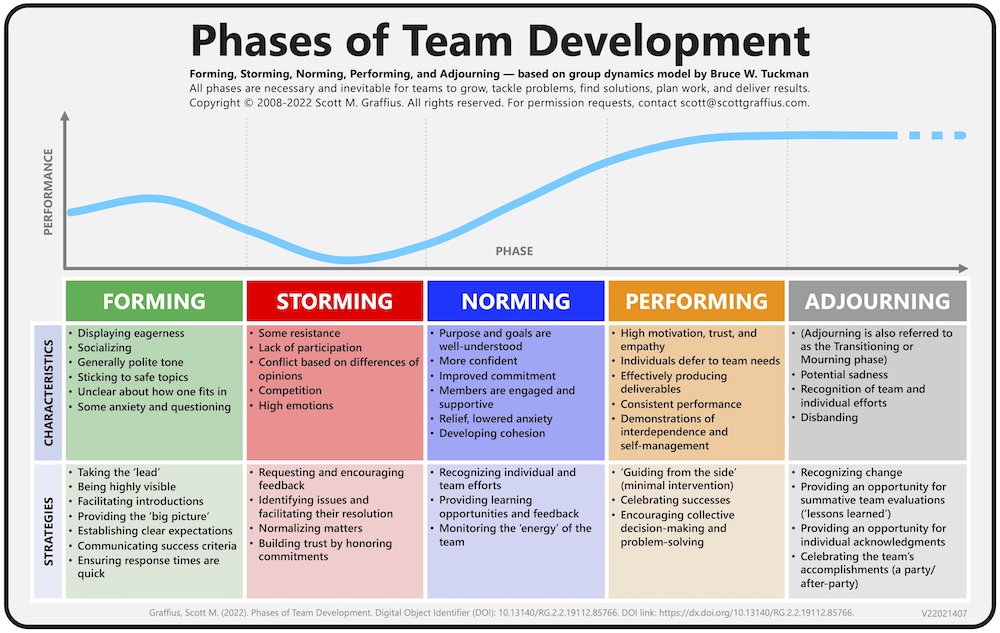I had the idea for this blog because of an article I saw recently on the Atlassian website. It tried to answer the question, “how do you build a kick-ass agile team”. Which is a great question. We would all benefit from knowing how to lead a team to greatness and how to know whether a team is on the path to greatness. Unfortunately their answer was based on a popular belief that teams start off by forming, then move through sequential stages of norming, storming and then performing. And this model is based on social scientific research that has been debunked..
So instead I want to answer Atlassian’s question by reaching into the decades of social science about what makes teams great, and how you can apply coaching and agile team practices to set teams on that path.
Tuckman’s model of Team Development

Research that debunks Tuckman’s sequential model of team development
In 2007 the Department of Defense published a study of 321 technical teams.
The goal of this research was to develop empirical evidence to determine whether or not the Tuckman model or some variant thereof provides an appropriate model to explain the development of small, short-duration technical teams within the Acquisition Community. The results showed, to a 95% confidence level, that only about 2% of 321 teams studies followed the Tuckman model.
Many teams skipped stages entirely or even passed through stages in a different sequence. And storming seemed to be happening consistently through the team’s lifecycle.
To be fair to Tuckman he had warned researchers that the application of this model to generic team settings may be inappropriate since the majority of his data came from the population of therapy groups and human relations training groups.
Connie Gersick in 1988 found the teams she studied progressed in a pattern of ‘punctuated equilibrium’ through alternating inertia and revolution in the behaviours and themes through which they approached their work. In other words, they made progress in their work by switching back and forth between doing nothing or very little, perhaps stuck in old habits and sprints of activity where they may be trying out new ideas and new ways of working together.
The team’s progress was triggered more by member’s awareness of time and deadlines than by the completion of an absolute amount of work in a specific developmental stage. Gersick found that lasting patterns for the team started very early in the team’s formation and persisted into periods of inertia. In addition, Gersick found that midpoints were significant milestones for teams, but it was midpoints between the time the team started a task / project and its deadline. This was the time that teams underwent great change.
Questions we want answers to about Teams
So if the developmental model of team development no longer works for us as a framework for coaching the team, then what does? And these are other questions we might pose:
- Why are many popular team building approaches that focus on behaviors insufficient for fostering team effectiveness?
- Why do team building events feel good but fail to improve team performance?
- Why are some of our teams great and others struggling?
- How can we prevent unnecessary conflict and authority struggles in teams while also increasing psychological safety and trust?
- How can we develop a team in half the time, at half the cost and with twice the impact?
- How can we rapidly form a team when time is tight?
The big idea here is that in fact six structural conditions of teams predict up to 80% of a team’s outcomes, and we have the evidence base to back that claim (6 Team Conditions)
A lot of the common team models in use today focus on behaviours of teams, or building psychological safety, dealing with conflict or building trust.
When you ask most people what influences team effectiveness, they will often say it’s our behaviors – and that makes sense, because behaviours are what we observe. However behaviours are emergent processes and in fact outcomes of the six key conditions. Behavioural approaches to team development may be addressing symptoms of dysfunction, but intervening at the root cause is the fastest route to successful change.
6 Team Conditions research suggests that focusing on behaviours is necessary but insufficient. The real lever is the underlying design condition or set of conditions. This is the ecosystem that is created that gives rise to the behaviours which lead to the outcomes that we’re interested in for teams.
Focusing on team building, trying to establish psychological safety, managing conflict, or getting teams to communicate well, are helpful, but they’re really treating the symptoms of a team, and do not have enough leverage to affect the trajectory of a team over time.
This is why a lot of traditional team approaches which tend to focus on behaviors don’t work. Because if you ignore the underlying design or structure of the team, your coaching efforts just won’t be sustainable over time.
For more information about 6 Team Conditions click the button below:

